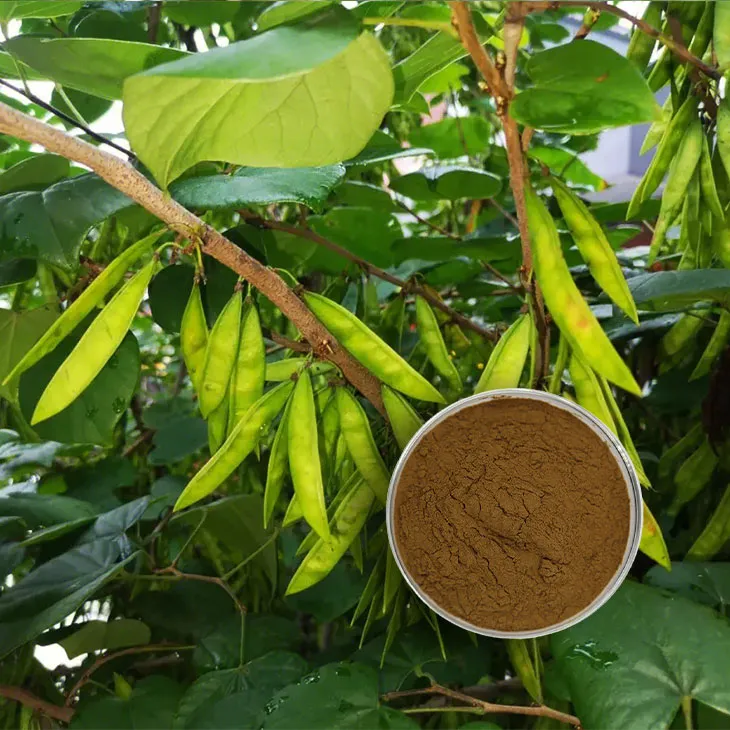- 0086-571-85302990
- sales@greenskybio.com
Overcoming Obstacles: Challenges in Saponin Extraction and Future Solutions
2024-08-05

1. Introduction
Saponins are a diverse group of natural compounds with a wide range of biological activities, including antioxidant, anti - inflammatory, and anticancer properties. Their potential applications in pharmaceuticals, cosmetics, and food industries have spurred significant interest in their extraction. However, the extraction of saponins is not without challenges. This article aims to provide a comprehensive analysis of the current challenges in Saponin Extraction and propose future - oriented solutions.

2. Challenges in Saponin Extraction
2.1. Extraction Solvents
The choice of extraction solvents is a crucial factor in Saponin Extraction. Traditional solvents such as ethanol and methanol are commonly used due to their ability to dissolve saponins effectively. However, these solvents also have several drawbacks.
Firstly, they are often flammable and pose safety risks during the extraction process. In industrial - scale extraction, large quantities of these solvents are used, increasing the potential for accidents. For example, improper storage or handling of ethanol can lead to fires or explosions.
Secondly, the cost of these solvents can be relatively high, especially when considering large - scale production. The price of high - purity ethanol or methanol can significantly contribute to the overall cost of saponin extraction.
Finally, some solvents may have environmental implications. Ethanol production, for instance, requires significant amounts of agricultural resources, and improper disposal of used solvents can cause pollution.
2.2. Energy Consumption
The extraction of saponins often involves energy - intensive processes. Heat - based extraction methods, such as Soxhlet extraction, are commonly used but consume a large amount of energy.
During Soxhlet extraction, the solvent is continuously evaporated and condensed, which requires a significant amount of heat input. This not only increases the cost of extraction but also has a negative impact on the environment due to the associated carbon emissions.
Moreover, some extraction techniques require high - pressure or high - temperature conditions, which further increase energy consumption. For example, in supercritical fluid extraction, maintaining the supercritical state of the fluid demands precise control of temperature and pressure, which consumes a substantial amount of energy.
2.3. Yield Optimization
Obtaining a high yield of saponins is a major challenge in extraction. Several factors can affect the yield, including the source material, extraction method, and extraction conditions.
The quality and composition of the source material play a significant role. Different plant species or parts may contain varying amounts of saponins. For example, the roots of some plants may have a higher saponin content than their leaves. However, harvesting the appropriate part of the plant at the optimal time can be difficult.
The extraction method also influences the yield. Some methods may not be able to extract all the saponins present in the source material. For instance, simple maceration may not be as effective as more complex extraction techniques in extracting saponins from plant matrices.
Extraction conditions, such as temperature, time, and solvent - to - material ratio, need to be carefully optimized. Incorrect settings of these conditions can lead to lower yields. For example, if the extraction temperature is too low, the solubility of saponins in the solvent may be reduced, resulting in a lower yield.

3. Future - Oriented Solutions
3.1. Advanced Engineering Solutions
New extraction equipment design can significantly improve the saponin extraction process. For example, the development of more energy - efficient Soxhlet - like extractors can reduce energy consumption. These new extractors could be designed with improved heat - exchange systems to minimize heat loss during the extraction process.
Another engineering solution is the application of membrane - based separation techniques. Membranes can be used to separate saponins from the extraction mixture, reducing the need for energy - intensive evaporation and condensation steps. This can not only save energy but also improve the purity of the extracted saponins.
Automation and process control can also play a crucial role in optimizing saponin extraction. By using advanced sensors and control systems, extraction conditions such as temperature, pressure, and solvent flow rate can be precisely controlled. This can ensure consistent extraction quality and potentially increase the yield.
3.2. Novel Scientific Research Directions
Research into new extraction solvents is an important area for future development. Green solvents, such as ionic liquids and deep eutectic solvents, have shown promise in saponin extraction. These solvents are often less flammable, more environmentally friendly, and may have different selectivity towards saponins compared to traditional solvents.
Genetic engineering of source plants could also be a potential solution. By modifying the genes of plants, it may be possible to increase the saponin content in the plants or make the saponins more easily extractable. For example, genes related to saponin biosynthesis could be overexpressed to enhance saponin production.
Combined extraction techniques may offer a new approach to improving saponin extraction. For instance, combining ultrasonic - assisted extraction with microwave - assisted extraction could potentially enhance the extraction efficiency and yield. The synergy between different extraction mechanisms may lead to better extraction results.

4. Conclusion
In conclusion, saponin extraction currently faces several challenges, including issues related to extraction solvents, energy consumption, and yield optimization. However, through advanced engineering solutions and novel scientific research directions, there is great potential to overcome these obstacles. The development of new extraction equipment, the exploration of green solvents, genetic engineering of source plants, and the combination of different extraction techniques all offer promising paths forward in revolutionizing the saponin extraction process. Continued research and innovation in this area will not only improve the efficiency and sustainability of saponin extraction but also expand the potential applications of saponins in various industries.

FAQ:
What are the main challenges in saponin extraction?
The main challenges in saponin extraction include issues related to extraction solvents. For example, finding a solvent that can efficiently extract saponins without causing degradation or unwanted chemical reactions. Energy consumption is another challenge. The extraction process often requires a significant amount of energy, which can be costly and not environmentally friendly. Yield optimization is also difficult. Maximizing the amount of saponin extracted while maintaining its quality is a complex task.
How do extraction solvents pose challenges in saponin extraction?
Extraction solvents can pose several challenges. Some solvents may not be selective enough, meaning they can extract other compounds along with saponins, leading to purification difficulties. Solvents might also have a negative impact on the saponin structure. Certain solvents can cause chemical modifications or degradation of saponins, reducing their quality and biological activity. Additionally, the choice of solvent can be limited by factors such as cost, toxicity, and environmental impact.
Why is energy consumption a significant challenge in saponin extraction?
Energy consumption is a significant challenge because the extraction methods often rely on processes such as heating, agitation, or high - pressure systems. These processes require a substantial amount of energy input. For large - scale extraction, high energy consumption can lead to increased production costs. It also has environmental implications as it may contribute to carbon emissions and non - sustainable energy use.
What are the difficulties in yield optimization during saponin extraction?
Yield optimization is difficult due to multiple factors. The variability in the raw materials, such as different plant sources or parts of plants used for extraction, can affect the amount of saponin available for extraction. The extraction conditions, including temperature, time, and solvent - to - sample ratio, need to be carefully balanced. If these conditions are not optimal, it can result in lower yields. Also, the presence of interfering substances in the raw material can reduce the efficiency of saponin extraction.
What are the future - oriented solutions for saponin extraction?
Future - oriented solutions include advanced engineering solutions. For example, the development of more efficient extraction equipment that can reduce energy consumption while increasing extraction efficiency. Novel scientific research directions also offer potential solutions. This could involve the discovery of new extraction methods based on enzymatic or biological processes. Additionally, research into improving the understanding of saponin chemistry may lead to better extraction strategies.
Related literature
- Saponin Extraction: Current Methods and Future Perspectives"
- "Challenges and Innovations in Saponin Extraction Technology"
- "Optimizing Saponin Extraction: A Review of Recent Advances"
- ▶ Hesperidin
- ▶ Citrus Bioflavonoids
- ▶ Plant Extract
- ▶ lycopene
- ▶ Diosmin
- ▶ Grape seed extract
- ▶ Sea buckthorn Juice Powder
- ▶ Fruit Juice Powder
- ▶ Hops Extract
- ▶ Artichoke Extract
- ▶ Mushroom extract
- ▶ Astaxanthin
- ▶ Green Tea Extract
- ▶ Curcumin
- ▶ Horse Chestnut Extract
- ▶ Other Product
- ▶ Boswellia Serrata Extract
- ▶ Resveratrol
- ▶ Marigold Extract
- ▶ Grape Leaf Extract
- ▶ New Product
- ▶ Aminolevulinic acid
- ▶ Cranberry Extract
- ▶ Red Yeast Rice
- ▶ Red Wine Extract
-
Hops Extract
2024-08-05
-
Lemon Extract
2024-08-05
-
White Peony Extract
2024-08-05
-
Horse Chestnut Extract
2024-08-05
-
Ginseng Root Extract
2024-08-05
-
Bitter Melon Extract
2024-08-05
-
Diosmin
2024-08-05
-
Red Vine Extract
2024-08-05
-
Panax Ginseng Leaf Extract
2024-08-05
-
Pueraria Lobata Extract
2024-08-05





















